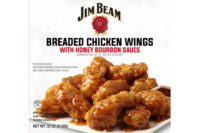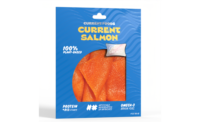TURKEY
Ready to Launch
By Megan Pellegrini, contributing writer
From oven-ready to preservative-free, turkey products are meeting consumer needs.
It’s pretty clear that turkey is not just for Thanksgiving. And the past year saw continued growth for the turkey industry, despite escalating feed prices and the resulting higher prices.
According to Sherrie Rosenblatt, vice president of marketing and communications, National Turkey Federation (NTF), based in Washington, D.C., the marketplace is seeing an increased demand for turkey products, with economic figures painting a sunny outlook. She notes that higher feed costs have affected the industry — every 1 cent increase in feed costs the industry $175 million — but haven’t dampened consumer demand.
In fact, 52 percent of the top 200 chains carried at least one turkey mention at the end of 2006, reported Food Beat Inc., based in Wheaton, Ill. The research firm noted a 20 percent increase in turkey mentions on chain restaurant menus over the past seven years. In addition, the survey found that turkey mentions in the second half of 2006 increased by 13 percent among quick-service chains and by 11 percent at family restaurant chains over the same period in 2005.
Coffee vendors like Starbucks and Caribou Coffee are also offering turkey in salads and sandwiches on their lunch menus.
Foodservice professionals’ interest in turkey recipes was reflected on the NTF’s EattTurkey.com database. In 2006, user sessions at the foodservice area of EatTurkey.com grew by 20 percent over 2005. Furthermore, Rosenblatt notes the NTF saw a 44 percent increase in the use of their foodservice-specific recipe database.
“The industry is looking for ways to provide consumers with a variety of products for breakfast, lunch and dinner,” she says. “Processors are also looking to utilize dark meats and ground products, such as sausage, burgers and meatballs.”
Hormel’s Jennie-O Turkey Store, for one, followed up on the successful launch last year of its Oven Ready line and VIP Entertaining Packs of holiday dinners this summer with turkey hot dogs, fully cooked turkey bratwursts made with 100 percent premium turkey meat and Scooby-Doo Turkey Franks.
Besides providing more convenient, flavorful products, the industry is also listening to consumer requests for “good-for-you products that go beyond health claims to include allergen concerns and the use of preservatives,” says Tom Collins, director of marketing for Willow Brook Foods, a turkey supplier based in Springfield, Mo. In foodservice, smaller portion sizes are also growing in importance to consumers.
Collins predicts the industry will also see more of a push into organic meat and poultry and Halal-certified products.
As food recalls from China continue to dominate the news, turkey producers would still be wise to also plan for future flu pandemics that can be particularly brutal to the poultry sector.
“In the U.S., food has never been safer, while consumers are now concerned about food or food ingredients produced in China,” he says. “However, preparation for an Avian Influenza outbreak needs to continue.”
| Annual Turkey Forecasts | |||||
| 2004 | 2005 | 2006 | 2007 | 2008 | |
| Production (millions lbs.) | 5,454 | 5,504 | 5,686 | 5,825 | 5,875 |
| Per capita disappearance* (retail lb.) | 17.0 | 16.7 | 16.9 | 17.2 | 16.9 |
| Turkey exports (millions lbs.) | 442 | 570 | 546 | 554 | 605 |
| *Per capita meat consumption data are revised, incorporating a new population series from the Commerce Department’s Bureau of Economic Analysis based on the 2000 Census. Source: World Agricultural Supply and Demand Estimates and Supporting Materials Published in Livestock, Dairy, and Poultry Outlook, www.ers.usda.gov/publications/ldp | |||||



Report Abusive Comment